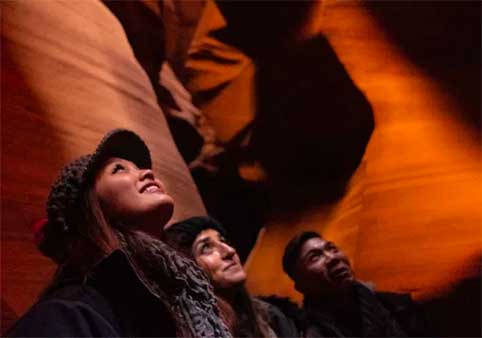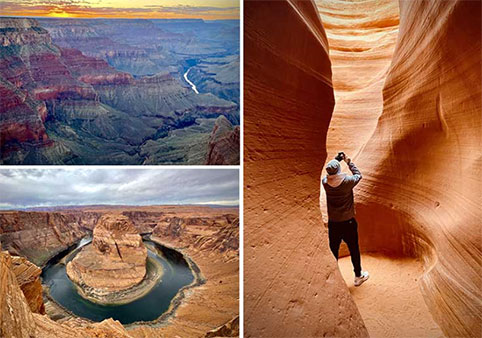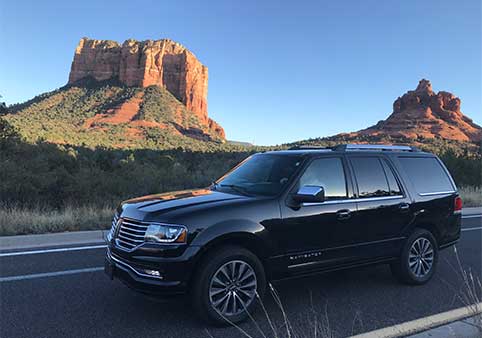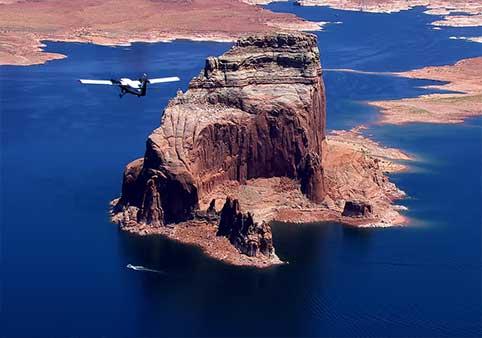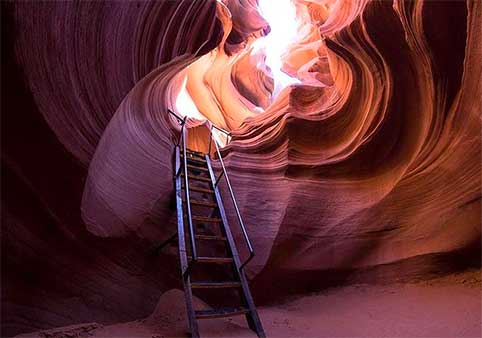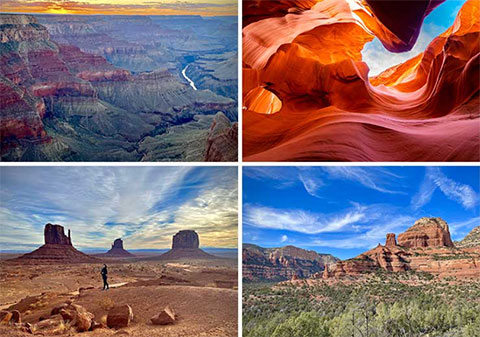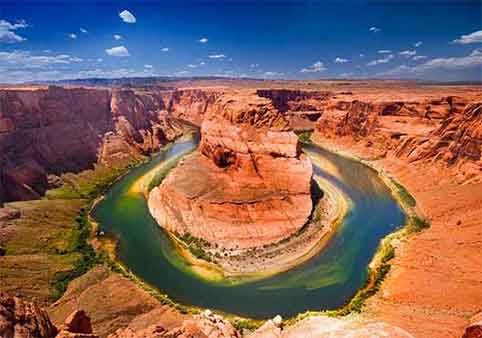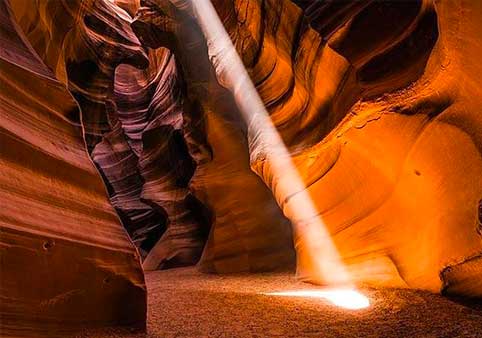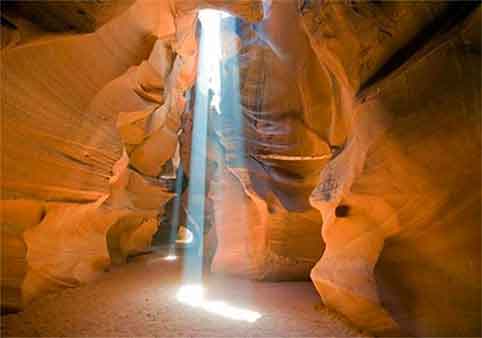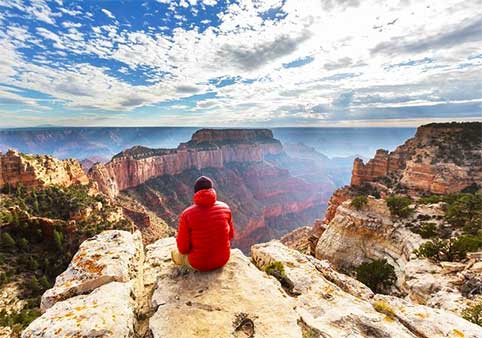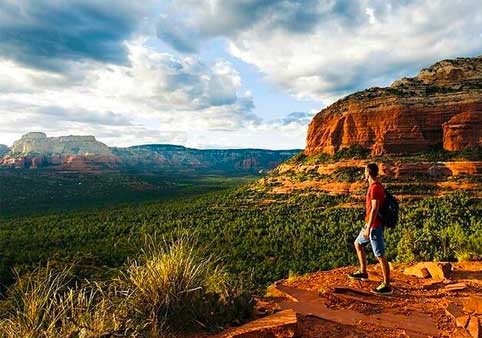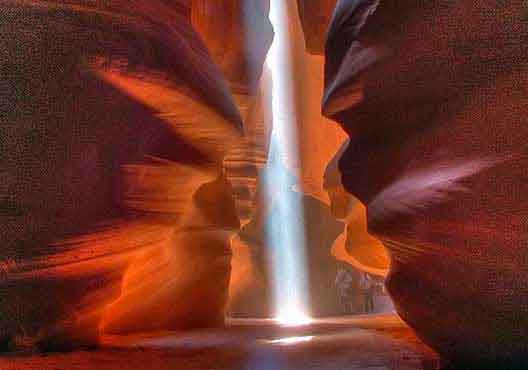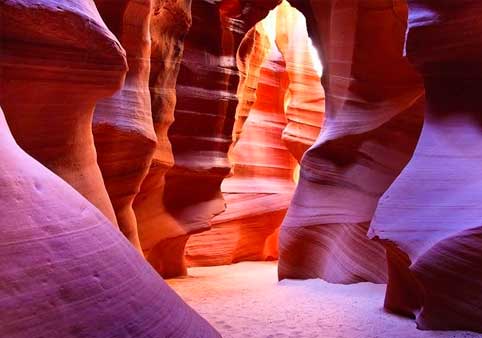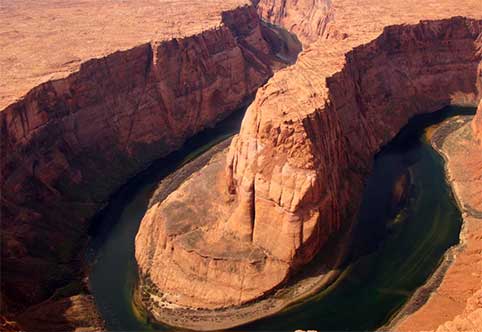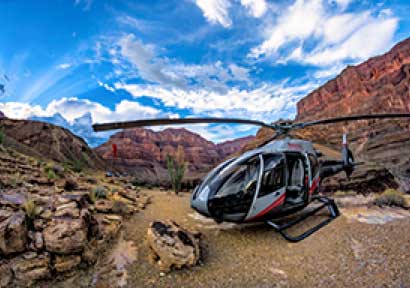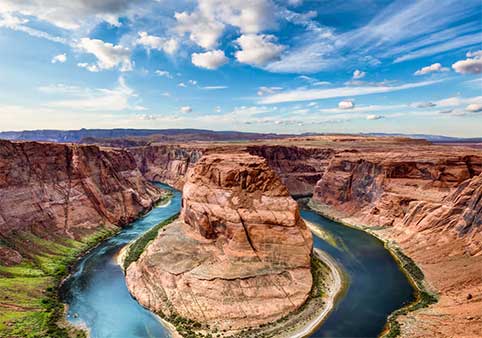Tours for Antelope Canyon
Antelope Canyon is one of the most recognized slot canyons in the American Southwest. It is located on Navajo land just east of Page, AZ. Antelope Canyon includes two separate, scenic slot canyon sections, referred to individually as "Upper Antelope Canyon" or "The Crack"; and "Lower Antelope Canyon" or "The Corkscrew". The Navajo name for Upper Antelope Canyon is Tsé bighánílíní, which means "the place where water runs through rocks". Lower Antelope Canyon is Hazdistazí, called "Hasdestwazi" by the Navajo Parks and Recreation Department, or "spiral rock arches". Antelope Canyon was formed primarily by flash flood erosion of the Navajo Sandstone, as well other sub-aerial processes such as heavy rain fall during monsoon season. Over time, the erosion created corridors that continue to grow wider as the hard edges of the stone gets smoother to form the characterisic flowing shapes in the rock. The sunlight in this slot canyon creeps into the dark passageways from above in the form of what appears to be etherial beams of light. It is for this reason that Antelope Canyon has become many photographers' dream subject.
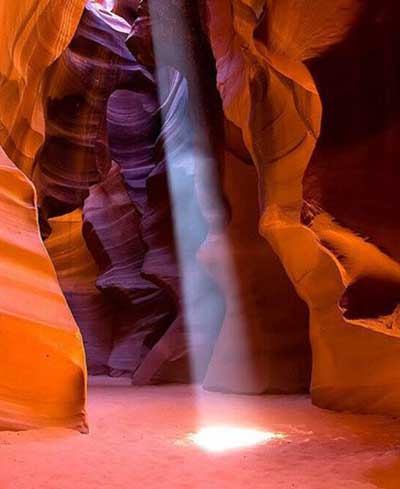
Both upper and lower Antelope Canyon can only be viewed and experienced on a guided tour. It is open 365 days a year, but tours are weather dependent. No slot canyon tours are available when risk of a flash flood is present. Therefore, it is best to plan your trip outside of monsoon season, which is generally late June though the month of August. In October of 2006, a flood occurred that lasted 36 hour which caused the Tribal Park Authorities to close Lower Antelope Canyon for five months. Make sure to check the status of your tour before you embark on your journey to the Great Southwest.
There are a few really good reasons to choose the Upper Antelope Canyon tour over the Lower Canyon. Upper Antelope Canyon is the tour where visitors will have the chance to witness the beams of light and sand falling over the rocks like a small waterfall. It's where most of the iconic photographs are taken, and therefore, is the more popular tour of the two canyons. Access is easier as well. This tour is on flat sand and does not require you to climb a ladder like the Lower Antelope Canyon tour does. The downside of choosing an Upper Antelope Canyon tour is that it can get very crowded. If you are sensitive to small spaces, the slot canyon can feel even more tight with the number of people down there, especially during the tours that are during the peak light beam hours (around 12:30-1pm). Also, the price of an Upper Antelope Canyon tour can be double the price of a Lower Antelope Canyon tour. Please note that "Photographer" tours are not available on weekends. It's just too busy and crowded on weekends for photographers to get the shots they desire. Overall, if you're wanting to experience the iconic Antelope Canyon, this is the section of the canyon for you! You can minimize crowds by going off season and during the week. Most Upper Antelope Canyon Sightseeing tours are 1 hour in the canyon and Photographer tours are 2 hours in the canyon.
Lower Antelope Canyon is beautiful and it features the same flowing Navajo sandstone walls, but it does not allow for guest to experience the beams of light nor falling sand as seen in many Antelope Canyon photographs. This section of the canyon attracts less people than Upper Antelope Canyon for a couple of reasons: as mentioned before, it does not allow visitors to experience the iconic beams of light and there is a ladder that requires guests to climb. But if you're the kind of visitor that prefers less crowds and doesn't mind climbing a ladder, a Lower Antelope Canyon tour may be your cup of tea. In addition, the cost of the tour is about half the price of an Upper Antelope Canyon tour! Most Upper Antelope Canyon Sightseeing Tours are 1 hour in the canyon and Photographer Tours are 2 hours in the canyon.
Best Antelope Canyon Tours
Antelope Canyon and Horseshoe Bend Tour
Tours from Flagstaff | Family-Friendly
3 Day 2 Night Private Roundtrip Tour from Phoenix / Scottsdale
Tours from Phoenix
Arizona Private Tours
Custom Options Available | Family-Friendly | Tours from Flagstaff
Las Vegas To Antelope Canyon Airplane Tour
This thrilling Antelope Canyon tour begins with a sightseeing airplane flight from Boulder City, Nevada, to Page, Arizona. En route, you'll enjoy aerial views of Lake Mead, Hoover Dam, and Glen Canyon. Transport awaits at Page Airport to escort passengers to some of the world-famous des … More
This thrilling Antelope Canyon tour begins with a sightseeing airplane flight from Boulder City, Nevada, to Page, Arizona. En route, you'll enjoy aerial views of Lake Mead, Hoover Dam, and Glen Canyon. Transport awaits at Page Airport to escort passengers to some of the world-famous destinations in this area. The adventure begins with a stop at the Horseshoe Bend overlook, the 270° curve of the Colorado River that has long been a photographer's favorite. This viewpoint is just a short hike before you encounter the iconic scenery.
The next stop in the journey is nearby Antelope Canyon for a guided tour of its interior wonder. Led by a Navajo guide, the winding slot canyon offers unique views you won't capture anywhere else, so have your camera ready. You'll explore the twisting canyon floor created by rippling stone walls and enjoy picturesque moments.
Family-Friendly | Tours from Las Vegas
Small Group Antelope Canyon Day Trip from Phoenix
Benefit from a full-day tour from Phoenix to Antelope Canyon to see more of Arizona’s natural beauty. Take in Route 66, Flagstaff, the San Francisco Peaks, Lake Powell, and a Navajo Trading Post on the way to Antelope Canyon. Then explore Antelope Canyon with a Navajo guide, and see the … More
Benefit from a full-day tour from Phoenix to Antelope Canyon to see more of Arizona’s natural beauty. Take in Route 66, Flagstaff, the San Francisco Peaks, Lake Powell, and a Navajo Trading Post on the way to Antelope Canyon. Then explore Antelope Canyon with a Navajo guide, and see the Colorado River from the Horseshoe Bend Overlook. Meals and hotel pickup and drop-off are included. Choose between a small-group or private tour.
Tours from Phoenix
4 Day 3 Night Private Roundtrip Tour from Phoenix/Scottsdale
Private Tour | Tours from Phoenix
Antelope Slot Canyon and Horseshoe Bend Day Tour from Sedona
Tours from Sedona
Private Transportation: Antelope Canyon and Horseshoe Bend from Las Vegas
Come Explore Antelope Canyon and Horseshoe Bend. Jump onboard your private tour vehicle from Las Vegas and we will transport you to a magical place! Experience Antelope Canyon & Horseshoe Bend, with private transportation. The original Navajo name Tsé bighánílíní means … More
Come Explore Antelope Canyon and Horseshoe Bend. Jump onboard your private tour vehicle from Las Vegas and we will transport you to a magical place! Experience Antelope Canyon & Horseshoe Bend, with private transportation. The original Navajo name Tsé bighánílíní means "the place where water runs through rocks." Antelope Canyon's sculpted sandstone walls offer memorable photo opportunities with a walkable corridor at the bottom of the canyon floor. It was formed by flash flood waters that rushed into the cracks of the Navajo sandstone along with the power of wind erosion. With the daylight dancing through the narrow openings from the top provides multiple kinds of light reflections and colors. This amazing changing color show makes this area a popular destination for photographers and tourists. From the canyon, you will visit an area where the Colorado River makes a 280 degree turn around the Horseshoe bend shape of the rock, hence its name of Horseshoe Bend.
Tours from Las Vegas | Private Tour
Antelope Canyon and Glen Canyon Scenic Tour
Grand Canyon South Rim, Antelope Canyon, Horseshoe Bend Day Tour from Las Vegas
Explore three of Arizona's most visited natural wonders in one day on this extended day trip from Las Vegas. Hike to Horseshoe Bend for a spectacular view along the Colorado River, admire the unique light beams at Antelope Canyon, and marvel at the Grand Canyon from the South Rim viewpo … More
Explore three of Arizona's most visited natural wonders in one day on this extended day trip from Las Vegas. Hike to Horseshoe Bend for a spectacular view along the Colorado River, admire the unique light beams at Antelope Canyon, and marvel at the Grand Canyon from the South Rim viewpoints. Along the way, drive along part of Route 66, and stop at the atmospheric town of Seligman.
Tours from Las Vegas
Upper Antelope Canyon Ticket
Sedona, Monument Valley & Antelope Canyon Experience 3D/2N from Las Vegas
Experience Sedona, Monument Valley & Antelope Canyon on this 3-day package through some of the most unique and stunning landscapes of the American West.
Experience Sedona, Monument Valley & Antelope Canyon on this 3-day package through some of the most unique and stunning landscapes of the American West.
Tours from Las Vegas
Antelope Slot Canyon and Horseshoe Bend Day Tour from Flagstaff
Tours from Flagstaff
Lower Antelope Canyon & Horseshoe Bend Tour from Las Vegas
Get out of Las Vegas for the day, soak up the views of some of the country's most striking landscapes, and be back on the Strip in time for a show. This guided tour takes you to the sandstone slot canyon of Antelope Canyon and to the dramatic Horseshoe Bend, carved from Navajo sandstone … More
Get out of Las Vegas for the day, soak up the views of some of the country's most striking landscapes, and be back on the Strip in time for a show. This guided tour takes you to the sandstone slot canyon of Antelope Canyon and to the dramatic Horseshoe Bend, carved from Navajo sandstone.
Tours from Las Vegas
